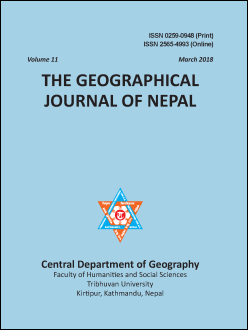An Assessment of Earthquake Risk in Thecho of Kathmandu Valley Nepal: Scenario and Reality
DOI:
https://doi.org/10.3126/gjn.v11i0.19553Keywords:
Earthquake, Disaster, Scenario analysis, Building vulnerability, RADIUS, Risk assessment, Awareness and preparednessAbstract
Natural disaster cannot be stopped but its effect can be minimized or avoided by adopting technology and necessary human adjustment. Earthquake is a natural event which occurs without early warning signs. Computer based earthquake scenarios are used worldwide to describe and estimate the damage from potential earthquakes. The current study is an attempt to explore potential risk with respect to physical infrastructure and assess modeled and actual physical damage and human loss caused by different earthquake scenario and actual 2015 earthquake event in Thecho of Kathmandu valley. The earthquake scenario is based on two nearest fault lines. Risk Assessment Tools for the Diagnosis of Urban Seismic Risk (RADIUS) method has been applied for estimation of potential building damage and casualties..The research has adopted integrated approach using secondary and primary data sources such as field observation, key informant survey and building survey through purposive random sampling.The study found that potential building damage estimated by RADIUS for Gorkha 2015 earthquake scenario and North-west (Khokana) are lower than the actual post-earthquake assessment whereas North earthquake scenario resulted higher loss. Actual damage caused by 2015 earthquake compared to modeled damage from RADIUS is found higher because additional damaged were made by successive aftershocks. Spatial distribution of potential building damage for earthquake scenarios and actual 2015 earthquake event is also variable. North-Nuwakot Earthquake Scenario resulted more hazardous than the North-Khokana scenario though the location of epicenter is relatively farther with high intensity. The study concluded that though earthquake occurrence and disaster is still less predictable risk assessment tools like RADIUS and mitigation measures based on such is important for reducing risk of earthquake disaster.
The Geographical Journal of Nepal
Vol. 11: 127-136, 2018
Downloads
1106
1694
Downloads
Published
How to Cite
Issue
Section
License
© Authors




